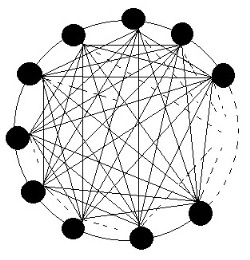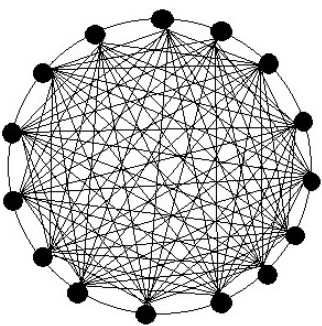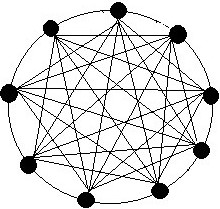Let
Graph theory has provided us with several useful tools, one of the
most studied and applicable tools is the topological index. Topological
indices (TIs) are the numerical parameters of a graph that can be
employed to characterize its topology. A topological index is also known
as a connectedness index in chemical graph theory, molecular topology,
and mathematical chemistry domains. A molecule can be represented as a
graph in the chemical graph theory, with atoms as vertices and bonds as
edges. Topological graph indices have been successfully utilized to
predict specific physicochemical properties as well as to determine the
structural properties of chemical compounds. Stankevich et al. [1] examined topological indices as
one way of identifying the relationship between the structure of the
chemical compound and its characteristics. Topological indices have also
assisted chemists, physicians, mathematicians, and others in solving
chemical and biological problems.
Diudea et al. [2] proposed a
unified approach to the Wiener topological index and its various
modifications, where they focus on the Schultz, Cluj, Szeged, Harary,
and Kirchhoff indices, as well as their numerous variants and
generalizations. They also obtained the relationship between these
indices and their correlations with the physicochemical properties of
molecules. Cancan et al. [3]
employed the findings obtained in [2] to investigate the generalized prism network.
Further, they have computed several degree-based indices such as the
Airthmetic-Geometric index, modified Randic, sum connectivity index, the
SK index,
The numerical representations of chemical structures with topological
indices are significant in medicinal chemistry and bioinformatics. In
the early 1990s, the invention and specification of the new TIs
increased consistently. Topological indices include degree-based,
distance-based, counting-related, and many other topological indices.
These indices are used to create quantitative structure-activity
relationships, in which a molecule’s biological activity, as well as
other properties like strain energy, stability, and boiling point, are
linked to its structure. To classify these indices, the structural
properties of the graphs are used to calculate the TIs. For example,
Zagreb indices are derived using the degrees of vertices and the wiener
index is obtained by using the distance between of vertices in the given
molecular graph. In 1947, [4]
the first graph-based molecular structure TI was discovered. Wiener has
provided only two important topological indices; the Wiener Index
Many studies have been reported regarding the applications of
topological indices in the last four decades. Das et al. [5] introduced several significant
characteristics of the second Zagreb index. In their work, they have
declared and verified numerous findings for
In the recent past, Poojary et al. [14] developed several topological indices and
polynomials for the Issac graph. Filipovski [15] established several relationships between the
Sombor index and degree-based topological indices such as the Zagreb
index, Forgotten index, and Randic index. Saleh et al. [16] introduced the first, second,
and forgotten downhill Zagreb indices of graphs. Saeed et al. [17] investigated degree-based
topological indices of Boron
The above-mentioned applications motivate us to study topological
indices for the orbit graph of
The following definitions related to the group theory, graph theory and topological indices are stated as below.
Definition 1. Dihedral Group:
Let
Definition 2. [20]The Set
Definition 3. [20]Orbit: If a group
Definition 4. [20]Orbit Graph

The following are some definitions that are used in computing the topological indices.
Definition 5. [21]Degree of a vertex: The number of
incident edges
Definition 6. [21]Distance: The minimum number of
edges between two vertices
Let
| Indices | Formulas | |
|---|---|---|
The orbit graph of all dihedral groups,
Theorem 1. [20]Let
According to Theorem 1, only
the third case involves a connected graph, while the other two cases
involve disconnected graphs. As a result, we can only think about the
case where
Theorem 2. Let
Proof. In order to calculate the indices of a graph, we have
to determine the number of vertices of the graph. From the definition
Since, we are considering the third case of the Theorem 1, where the graph is complete then the
number of edges of the orbit graph are
Example 1: Consider the orbit graph
Now, the graph

Also, the degree and distance of vertices are
In this section, we relate each of the indices with the Wiener index and also their relationship with each other.
Theorem 3. For orbit graph of dihedral
group,
Proof. As we obtain the modified schultz index for the orbit
graph of dihedral group in the above Theorem 2. Then we have
Since,
and it is obvious from the above prove result that
Theorem 4.
Proof. Since,
Theorem 5. For orbit graph of dihedral group,
the second Zagreb index is the product of Wiener index and the first
Zagreb index.
Proof. we obtain
Theorem 6.
Proof.
Theorem 7.
Proof.
Also,
Theorem 8.
Proof. By splitting the
Theorem 9.
Proof. From Theorem 2, we obtain
Theorem 10. For the orbit graph of dihedral
group, Forgotten index is the twice of second Zagreb index and modified
Schultz index
Proof. From Theorem 2,
Now,
Since,
Also,
In this section, we obtain the polynomial of each index for the orbit graph of the dihedral group.
Theorem 11. Let
Proof. From Theorem 2, the result is obvious.
Example 2: Consider the orbit graph
Now, the graph

Also, the degree and distance of vertices are
Because topological indices can only be computed for connected graphs, we only consider the third case of the dihedral group’s orbit graph. Since the orbit graph of a dihedral group is complete, we obtain the indices by generalising the Wiener index, the first, second and third Zagreb indices, the Hyper first and second Zagreb indices, the Schultz and modified Schultz indices, the Somber index, the Forgotten index, and the Randic and Reciprocal Randic indices of a complete graph. We also learn how these indices relate to the Wiener index for the orbit graph of the dihedral group. Furthermore, the polynomial for the indices of the group’s orbit graph has been determined.
The authors would like to express their sincere thanks to referee(s) for comments and remarks.
1970-2025 CP (Manitoba, Canada) unless otherwise stated.